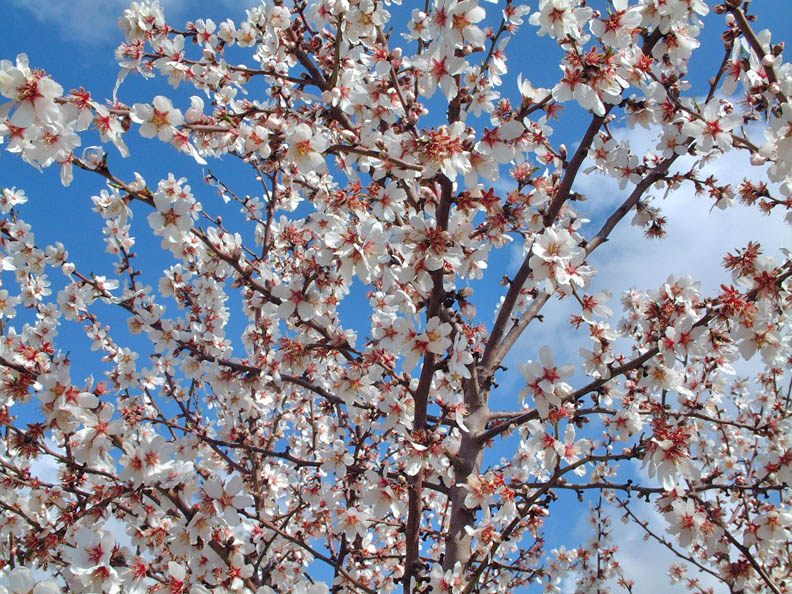February 8, 2013

Honey bees are more effective at pollinating almonds when other species of bees are present, says an international research team in ground-breaking research just published in the Proceedings of the Royal Society. The research, which took place in California’s almond orchards in Yolo, Colusa and Stanislaus counties, could prove invaluable in increasing the pollination effectiveness of honey bees, as demand for their pollination service grows.
When blue orchard bees and wild bees are foraging in almonds with honey bees, the behavior of honey bees changes, resulting in more effective crop pollination, said lead author Claire Brittain, a former post-doctoral fellow from Leuphana University of Lüneburg, Germany and now associated with the Neal Williams lab at the University of California, Davis. Wild bees include non-managed bees such as bumble bees, carpenter bees and sweat bees.
“These findings highlight the importance of conserving pollinators and the natural habitats they rely on,” Brittain said. “Not only can they play an important direct role in crop pollination, but we also show that they can improve the pollination service of honey bees in almonds.”
Agroecologist Alexandra-Maria Klein, a professor at Leuphana University of Lüneburg, Germany, served as the project lead while a postdoctoral fellow in the UC Berkeley lab of conservation biologist/professor Claire Kremen. Klein and Kremen initiated the project in 2008 and continued working on the project together in 2009 and 2010.
The research, “Synergistic Effects of Non-Apis Bees and Honey Bees for Pollination Services,” appears in the Jan. 9th edition. California’s almond acreage now totals 800,000s, and each acre requires two bee hives for pollination. Honey bee-health problems have sparked new concern over pollination services.
Klein, Kremen and pollination ecologist Neal Williams, assistant professor of entomology at UC Davis, co-authored the research, which encompasses 2008-2010 data.
“In orchards with non-Apis (non-honey bees), the foraging behavior of honey bees changed and the pollination effectiveness of a single honey bee visit was greater than in orchards where non-Apis bees were absent,” the researchers wrote in their abstract.
Bee diversity vital
Brittain said that the field experiments “show that a diversity of pollinators can improve pollination service, through species interactions that alter the behavior and effectiveness of a dominant pollinator species.”
“This is one of our first demonstrations on how to increase the efficiency of honey bee pollination through diversification of pollinators,” said Williams, who joined the team in 2010. “With increasing demands for pollination-dependent crops globally, and continued challenges that limit the supply of honey bees, such strategies to increase pollination efficiency offer exciting potential for more sustainable pollination in the future.”
The declining population of honey bees, particularly due to colony collapse disorder (CCD) is troubling. Bee scientists attribute the mysterious malady to multiple factors, including pests, parasites, diseases, malnutrition and stress.
“Almond is a $3 billion industry in California,” said Kremen, who is also an affiliate with the UC Davis Department of Entomology and works closely with scientists at the Harry H. Laidlaw Jr. Honey Bee Research Facility, UC Davis. “Our study shows that native bees, through their interactions with honey bees, increase the pollination efficiency of honey bees--the principal bee managed for almond pollination--and thus the amount of fruit set.”
Native pollinator specialist Robbin Thorp, emeritus professor of entomology at UC Davis, identified the bees in the Klein-Kremen project. The species he identified for the project in 2008-2009 totaled 50 species, including bumble bees, small carpenter bees, sweat bees, digger bees, mining bees and blue orchard bees.
Brittain, who received her doctorate from the University of Reading, UK, on the impact of pesticides on pollinators, began working on the study as a post-doctoral researcher in the Klein lab in Germany, and as a visitor in the Williams lab in Davis.
Future directions? “The project is ongoing and we plan to investigate further the mechanism behind the increased effectiveness of honey bees when other bees are present,” Brittain said. “We are also going to be looking at how to enhance floral resources for wild bees in almond orchards.”
“Now we know about bee behavior—that they move more between orchard rows when non-Apis bees are around—we need to study the reason why they move,” Brittain noted. “One route we will be exploring is the chemical footprints that the bees are leaving on the flowers.”
Professor Klein lectured on “Can Wild Pollinators Contribute, Augment and Complement Almond Pollination in California” at a seminar on Feb. 17, 2010 to the UC Davis Department of Entomology. Her seminar was video-recorded and can be viewed here: https://admin.na4.acrobat.com/_a841422360/p37649788/.
Almonds are California’s biggest export. The National Agricultural Statistics Service is forecasting a record-breaking 2.10 billion meat pounds this year, valued at approximately $3 billion. Eighty-percent of the global supply of almonds is grown in California, and about 70 percent of California’s crop is marketed overseas.
To pollinate California’s almond orchards, approximately 2.6 million colonies are required. They are trucked into California from all over the country for the almond pollination season, which typically begins around Valentine’s Day.
You May Also Like




